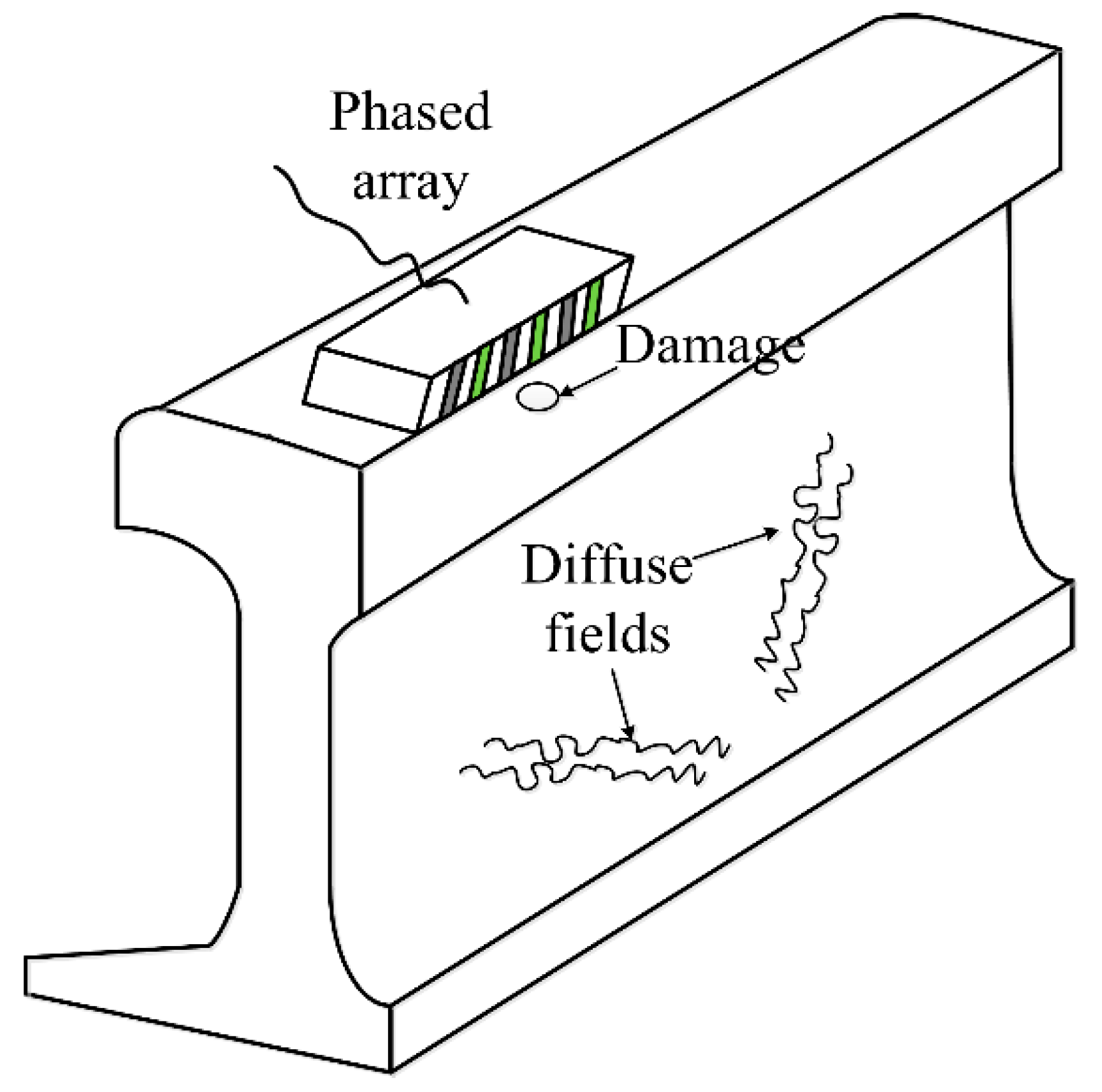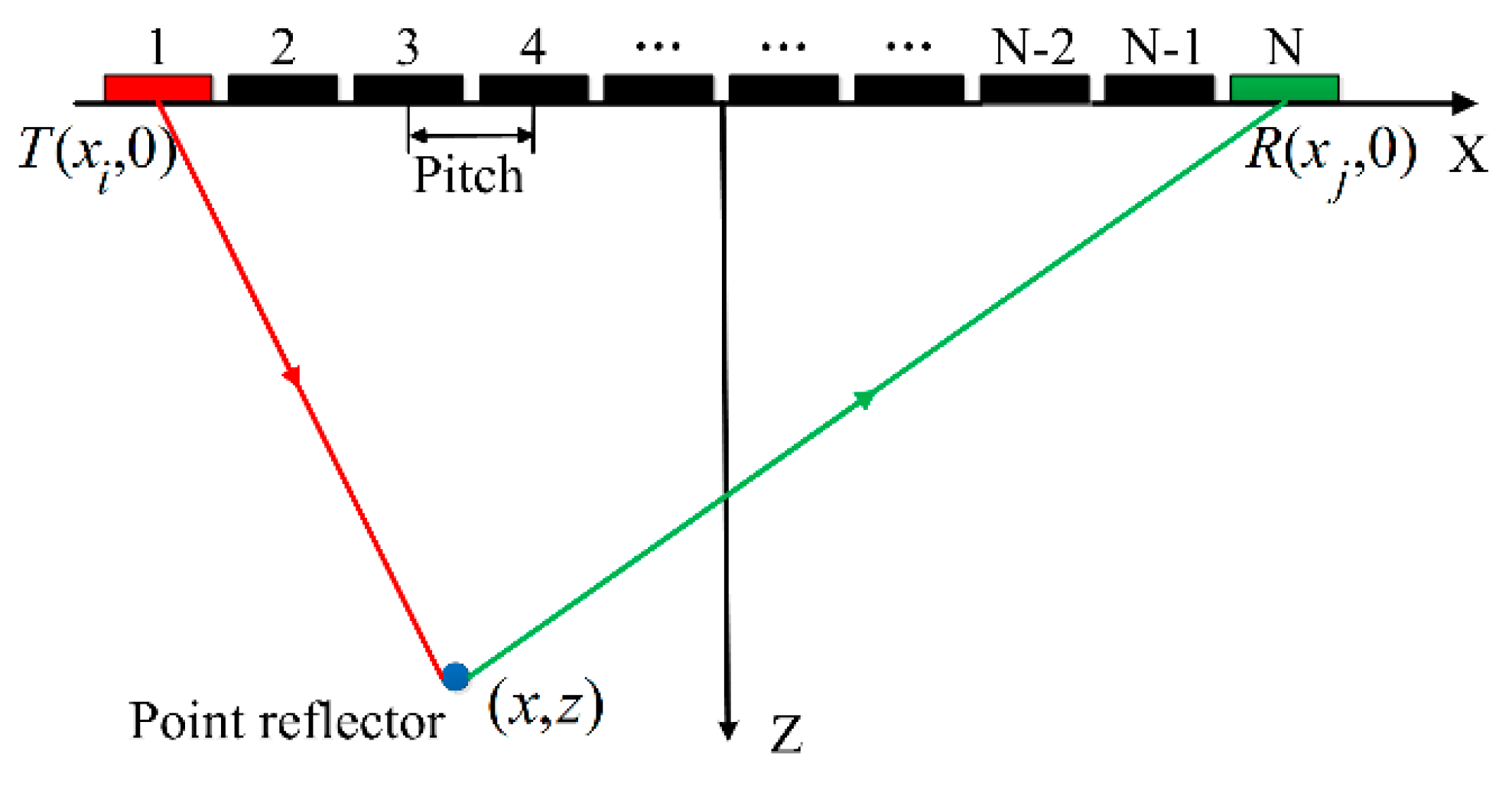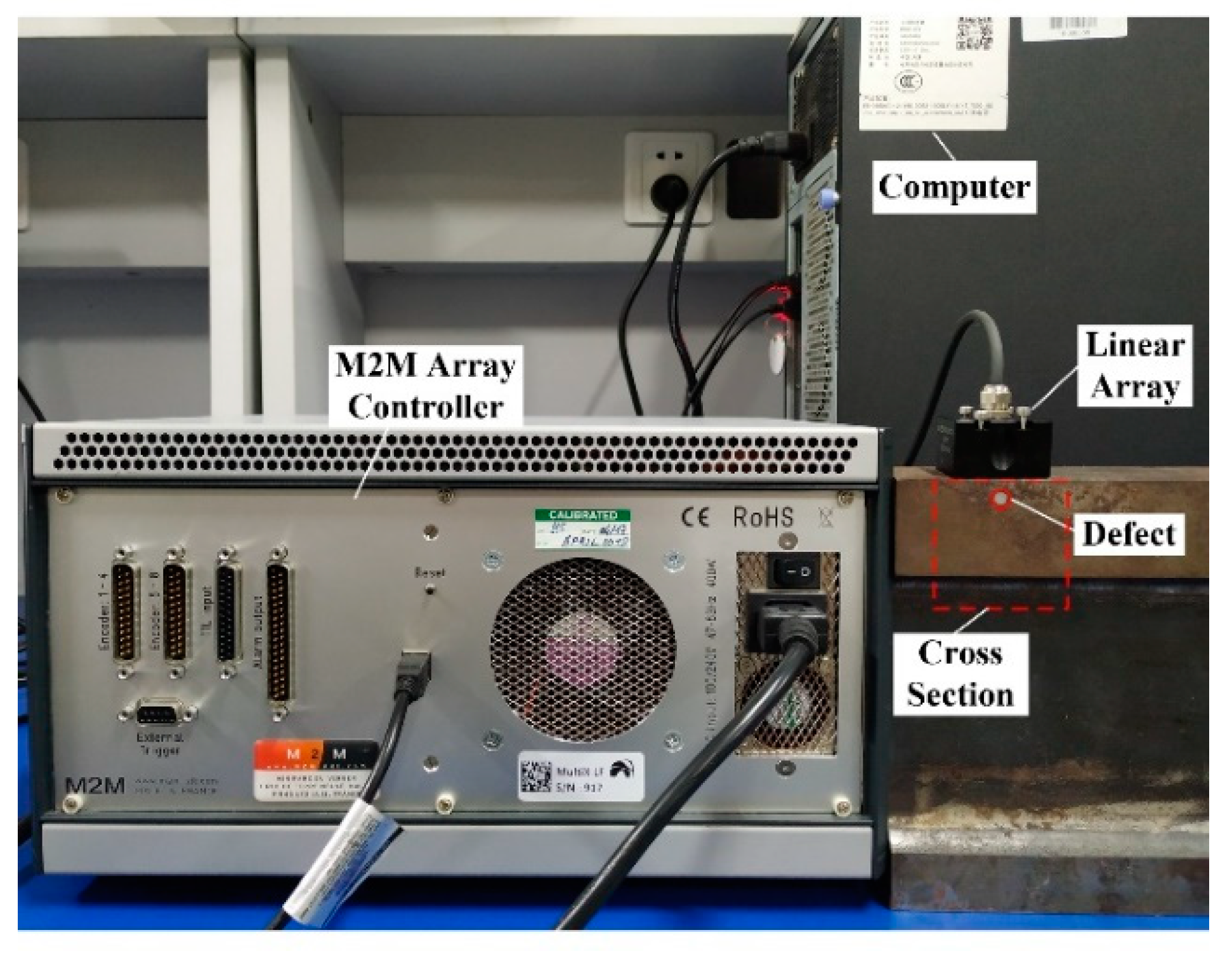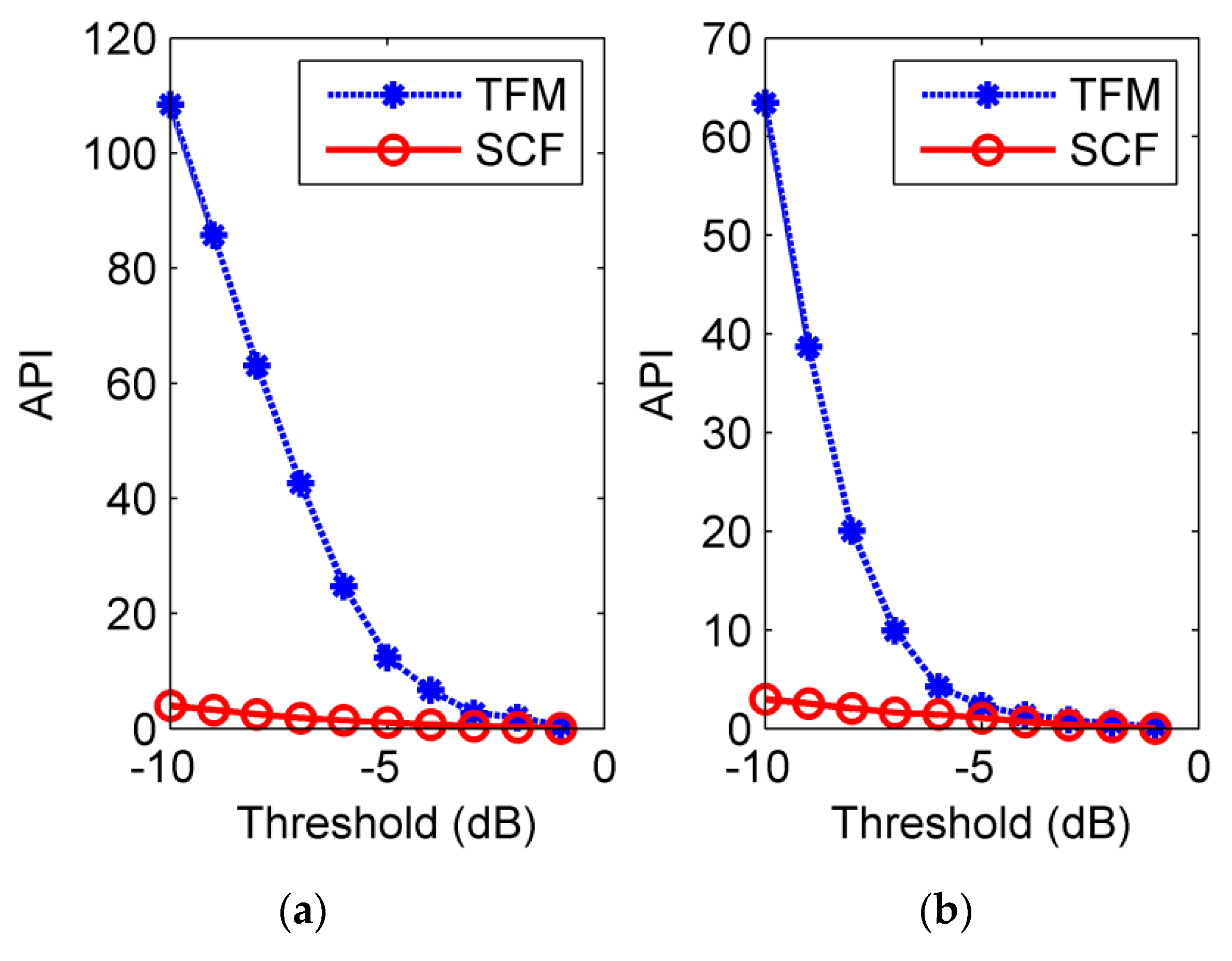1. Introduction
The defect detection of rails means a great deal to the safe operation of the railway system and industrial applications. Corrosions, cracks, and cavities in rails not only shorten the life of the railway services but also lead to potential security risks. Therefore, it is of great significance to pursue structural health monitoring (SHM) of rails. As one of the popular SHM technologies, ultrasonic phased array has been developed and widely used in recent years. By exciting the array elements in a specified sequence, one array probe can steer and focus the wavefront into a structure, allowing the generation of structure images [
1]. However, in practice, there is always a blind zone immediately in front of the inspection system and it extends to several millimeters in common engineering. This causes the direct arrival of ultrasonic phased arrays containing the undesired signals, where early detection of signals will be obscured [
2].
A promising method to solve this problem is the cross-correlation of diffuse fields. This approach can retrieve Green’s function between two points from a diffuse field. In 1999, Claerbout et al. [
3] proposed a hypothesis that cross-correlation of seismic traces formed by randomly distributed deep seismic sources can generate virtual ground seismic records. A coherent wave field was constructed by calculating the cross-correlation of noise recorded at two locations on the surface. In 2001, Weaver et al. [
4] validated that the impulse response of the structure between two receiving points can be extracted by using the cross-correlation of noise recorded at two receiving points in random noise fields. The retrieved signals were only different in magnitude from Green’s function. From then on, due to the ability of retrieving deterministic signals (Green’s function) from random signals, this method has been applied in many fields, such as electromagnetics [
5], seismology [
6,
7], ocean acoustics [
8], civil engineering [
9], medicine [
10], and ultrasonics [
11]. In 2004, under the isotropic scattering assumption, Snieder et al. [
12] deduced the feasibility of recovering Green’s function of the ballistic wave from the coda. The global requirement of the equipartitioning of normal modes was held if the scattered waves propagated quasi-isotropically near the receivers. Subsequently, after considering the limitation of time-reversal invariance in correlating noise, he found that it was possible to obtain Green’s function of diffusion by correlating the solutions of the diffusion equation that were excited randomly [
13]. This property was used to retrieve Green’s function for diffusive systems from ambient fluctuations. In 2011, Moulin et al. [
14] tested ambient vibrations for passive real-time monitoring of structures by low-frequency random vibration data, which was collected on an all-aluminum naval vessel operating at high speed. In 2014, Roux et al. [
15] evaluated the relative contributions of source distribution and medium complexity in the two-point cross-correlations, showing that the fit between the cross-correlation and the 2D Green’s function strongly depended on the nature of the excitation source. In 2015, Chehami et al. [
16] applied passive listening to monitor the occurrence of defects in thin aluminum plates. The defects were localized successfully from noise generated by different sources between 10 and 40 kHz in metallic plates. In 2017, with the experiment on both aluminum and CRFP blocks, Potter et al. [
2] showed that a reconstructed full matrix which contained the near-surface information can be produced through cross-correlation of a diffuse full matrix.
The total focusing method (TFM) is a traditional post-processing imaging algorithm for phased array and shows great potential in defect detection and characterization. It was introduced by Holmes [
17] in 2005. TFM utilizes all possible combinations of sending and receiving elements to form an image. Compared to the other imaging methods, for example, the B-scan mode (whose image is constructed line by line and by focusing at a given depth), the TFM allows to focus on every point of the image area. TFM is considered the “gold standard” that provides high resolution and a larger dynamic range. However, because there is only one element used at every emission, the energy sent into the medium is limited. Thus, the signal-to-noise ratio (SNR) of TFM is low compared to equivalent imaging implemented using conventional parallel transmit beam-forming. In addition, the image artifacts of TFM will lead to misinterpretations, which may ultimately cause low image quality.
Recently, a novel method, phase coherent imaging, has been proposed to improve the quality of ultrasound images [
18]. Based on a statistical analysis of the instantaneous phase of the aperture data, a phase coherence factor is computed for every sampling point. If all echoes are from the focal region, they overlap perfectly after inserting the beam-forming delays and the variance of their phases is close to zero. The echo signal can be kept in the output image as the coherence factor is unity. On the other hand, if the echoes come from noise, the variance of their phases is non-zero. The coherence factor greatly reduces the noise amplitude in the output image. In order to simplify the implementation of this technique, the sign bit of the digitized received echo can be considered as a representative of the instantaneous phase. The sign coherence factor (SCF), a special phase coherence factor, can be obtained from the variance of the sign bit. It has been demonstrated that SCF simultaneously reduces undesirable echoes and the main lobe width. In this work, the application of SCF to increase spatial resolution and SNR for near-surface imaging in rails is investigated. The theoretical background of the work is presented first. Then, experiments are conducted in rails with a linear 32-element phased array. To recover near-surface information, Green’s function is retrieved from the cross-correlation of a diffuse full matrix. The output images are formed by TFM and SCF using Green’s function. Finally, the performance of the two algorithms for the near-surface defect is compared and conclusions are presented.
This paper is organized with seven sections, including this introduction.
Section 2 demonstrates the theoretical background of this work.
Section 3 presents the experimental apparatus for near-surface detection. Experimental results are illustrated in
Section 4.
Section 5 compares the performance of TFM and SCF algorithms in terms of array performance indicator (API) and SNR.
Section 6 provides a recommendation for future research.
Section 7 makes a conclusion of the findings.
5. Analysis and Discussions
Close to the array, there is a strong blind zone, which is a region with high intensity artifacts. The near-surface defects cannot be shown by the conventional TFM method. On the one hand, the direct arrivals of phased arrays are characterized by the limited time associated with the conversion from the transmission to the reception operation, as well as the saturation from the transmission of the initial activation and the nonlinear electronic recovery process. On the other hand, the adjacent elements of phased arrays cause electrical and mechanical cross-talk, which also brings nonlinear effects into an early acoustic time of signals. In addition, the time of flight of the direct propagation and multiple reflections between the elements is short when compared to the echoes coming from the defects. Therefore, it reduces defect contrasts and masks defects located close to the array. The blind zone is pronounced in TFM image. To overcome this limitation, the Green’s function is recovered from the cross-correlation of the diffuse field. It makes near-surface imaging possible for post-processing algorithms, as shown in
Figure 7 and
Figure 8. Besides, the image processed by SCF will have better quality. Pixels in the TFM image are summed by the amplitude of signals, which is easily affected by noise. In SCF image, pixels corresponding to reflections from the main lobe are strongly weighted whereas those corresponding to grating lobe reflections have a low weight. This technique would improve spatial resolution and SNR.
Figure 9 shows the effect of different α for specimen 2 imaging. The first line is TFM images and the second line is SCF images. The parameter α determines the transition of the output image. The low α, whose value is 20 × 10
5 s
−1, has a smooth transition in
Figure 9a. However, more noise in the diffuse full matrix will be brought into the TFM image in the depth of about 20 mm to 50 mm. In
Figure 9b, a relatively higher value of the parameter α, which is 20 × 10
6 s
−1, is presented for imaging. Compared with
Figure 9a, the noise is suppressed, and the image quality is improved. Another noteworthy feature is that there is a discontinuity at a depth of about 20 mm. Actually, considering the early time information and the later time information of the hybrid full matrix that come from conventional and reconstructed matrices, respectively, the data of the two matrices is different and the perfect combination of them can be hard to achieve, especially when defects are at different depths. To the authors’ knowledge, there is no algorithm or method that can determine the right value of parameter α. Therefore, suggesting an exact α is difficult in practice but we recommend that the range should be in [10
5, 10
7]. Beyond this range, the image quality will be degraded, even when the output image is weighted by SCF. In
Figure 9c,d, contrary to TFM images, SCF images present good robustness to noise and keeps a high value of SNR to different α. What’s more, due to the reduction of grating lobe artifacts, all target defects remain visible and SCF images are not disturbed by discontinuity.
In order to quantitatively compare the performance of TFM and SCF imaging methods for near-surface point-like defects, the API and SNR are calculated. They are expressed by the following equations:
where
A is the area over which the amplitude of the point-spread function (i.e., the image of an omnidirectional point scatterer) is greater than some threshold below its maximum value and λ is the wavelength at the center frequency. The API is a dimensionless quantity that represents the spatial extent of the point-spread function. Therefore, the function
p depends on the imaging point and the threshold value. Note that a low value of API is desirable.
where
Imax is the maximum value of the defect signal and
Iaverage is the average amplitude of the background noise level.
A rectangular region (from −7.5 to 7.5 mm in the
X-axis, from 0 to 15 mm in the
Z-axis) of specimen 1 is shown in
Figure 10. The image of TFM in
Figure 10a,b and that of SCF in
Figure 10d,e are presented. In
Figure 10a,b, the noise emerges dramatically near the surface and side lobes exist in the TFM images. Artifacts with different degrees occurred with the TFM and degraded the image quality. However, with the usage of the SCF, the output images have the ability to suppress side lobes and grating lobes, as shown in
Figure 10d,e.
Figure 10c,f demonstrate the corresponding point-spread functions. In
Figure 10c, noise is obviously observed at a depth of around 0 mm to 15 mm and the areas over the amplitude at −6 dB are 75.55 mm
2, which are more than the areas of real defects in specimen 2. Furthermore, the side lobes result in misinterpretations of the defect. On the contrary, in
Figure 10f, noise is effectively suppressed. The areas over the amplitude of −6 dB are all in the defect region and the side lobes are not present. This shows that SCF realizes better spatial resolution than TFM with data originating from diffuse fields. Another rectangular region (from −9 to 9 mm in the
X-axis, from 0 to 45 mm in the
Z-axis) of specimen 2 and the corresponding point-spread functions are shown in
Figure 11.
To further illustrate the advantage of SCF,
Figure 12 investigates the dependence of the API on different threshold values of the defect located at the same depth
z = 8 mm. The range of threshold values are −10 to −1 dB. There is a significant difference in the API between TFM and SCF. In both cases, APIs for SCF remain stable at a low level. Alternatively, for lower thresholds, the APIs corresponding to the TFM increases much faster than APIs for SCF, especially for threshold values less than −4 dB. The APIs of TFM on low threshold values are unusually high and they are caused by noise. As for near-surface imaging in this paper, the noise comes not only from the diffuse scattering medium but also from the imperfect reconstruction of Green’s function. In fact, there is no formal guarantee that the noise cross-correlation function would yield an unbiased estimate of the full Green’s function. Thus, the amplitude distribution of the extracted coherent signals from the cross-correlation function is different from the amplitude distribution of the arrivals of the actual Green’s function. Moreover, for the limited number of averaging operations, the recovery of Green’s functions within the reconstructed full matrix is less accurate than directly acquired signals.
Another rectangular region (from −10 to −5 mm in the
X-axis, from 0 to 5 mm in the
Z-axis) is regarded as the background, which is used for the average amplitude of the background noise level
Iaverage evaluation. The parameter
Imax is calculated as the maximum value of the near-surface defect signal. The comparison of SNR for different specimens is presented in
Figure 13. The images processed by conventional TFM have low SNR saturation effects and this problem often exists in the traditional ultrasonic inspection. By exploiting the cross-correlation of diffuse fields, saturation effects are prevented effectively, and the SNR is improved due to the recovery of Green’s function. For better image quality, SCF is used with the hybrid full matrix. It can be seen that SCF images have the highest SNR and achieve optimal performance.


















